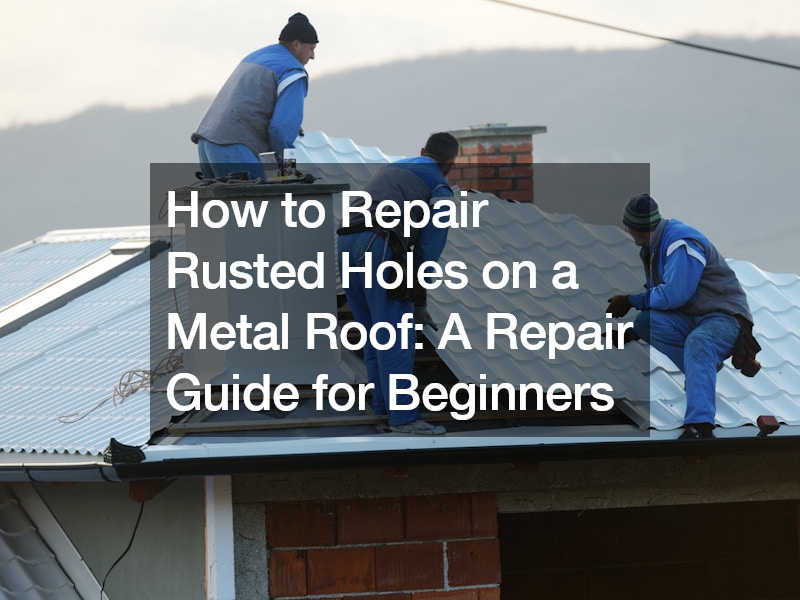
Metal roofs are renowned for their durability and longevity, but over time, rust and corrosion can lead to holes that compromise their effectiveness. Repairing these rusted holes is crucial to maintaining the integrity of your roof and preventing leaks that can damage your home’s interior. In this guide, we’ll walk you through the process of repairing rusted holes on a metal roof, offering simple steps and easy-to-understand instructions suitable for beginners.
Understanding the Problem:
Before diving into the repair process, it’s essential to understand why rusted holes occur on metal roofs. Exposure to moisture and environmental elements can cause metal surfaces to corrode over time, leading to the formation of rust.
If left untreated, this rust can eat away at the metal, creating holes that compromise the roof’s waterproofing abilities.
Assessing the Damage:
Start by conducting a thorough inspection of your metal roof to identify any areas of rust or existing holes. Look for signs of bubbling paint, discoloration, or visible rust spots. These are indicators of underlying corrosion that may have already caused holes to form. Take note of the size and location of the holes to determine the extent of the damage.
Gathering Materials:
To repair rusted holes on a metal roof, you’ll need the following materials:
- Turbo Poly Seal or similar roofing sealant
- Fleece or fabric patch
- Silver Coat Protection or UV-resistant roof coating
- Asphalt and Tar Remover for Hands (optional but recommended for cleaning)
Cleaning the Area:
Before beginning the repair process, it’s crucial to clean the area around the rusted holes thoroughly. Use a wire brush or sandpaper to remove any loose rust, dirt, or debris from the surface. For stubborn stains or tar residue, consider using Asphalt and Tar Remover for Hands to ensure a clean and smooth surface for the repair.
Applying Turbo Poly Seal:
Once the area is clean and dry, apply Turbo Poly Seal or a similar roofing sealant directly over the rusted holes. Ensure complete coverage of the affected area, extending beyond the edges of the holes to create a watertight seal. Use a brush or roller to spread the sealant evenly, and allow it to dry according to the manufacturer’s instructions.
Adding a Fabric Patch:
For added reinforcement, place a fleece or fabric patch over the sealed area while the sealant is still tacky. Press the patch firmly into place, ensuring full contact with the sealant to create a strong bond. The patch will help reinforce the repair and provide additional protection against leaks.
Applying Silver Coat Protection:
Once the sealant has dried completely, apply a layer of Silver Coat Protection or UV-resistant roof coating over the repaired area. This coating will help protect the repair from UV damage and extend its lifespan. Use a brush or roller to apply the coating evenly, covering the entire repaired section of the roof.
Maintaining the Repair:
Regular maintenance is essential to ensure the longevity of your metal roof repair. Inspect the repaired area periodically for signs of damage or wear, and reapply Silver Coat Protection as needed to maintain its protective properties. Additionally, keep gutters and downspouts clear to prevent water from pooling on the roof and causing further corrosion.
Identifying Common Signs of Roof Damage
Being able to recognize common signs of roof damage is crucial for homeowners to address issues before they worsen. Look out for leaks, water stains on ceilings or walls, and damp insulation, as these could indicate roof leaks. Sagging areas, loose or missing shingles, and damaged flashing are also red flags that warrant immediate attention. Additionally, inspect the roof for rust spots, corrosion, or holes, especially around seams and joints. Regularly checking for these signs allows homeowners to take proactive measures to repair damage and maintain the integrity of their metal roof.
Preventative Maintenance Tips
Regular maintenance is key to extending the lifespan of a metal roof and preventing rusted holes. Start by scheduling annual inspections to identify any signs of wear, corrosion, or damage early on. Clear debris such as leaves, branches, and dirt from the roof surface, gutters, and drainage systems regularly to prevent moisture buildup. Additionally, trim overhanging branches to reduce the risk of damage from falling limbs. Consider applying a protective coating or sealant to the metal surface to provide an extra layer of defense against rust and corrosion. Finally, address any minor issues promptly before they escalate into larger problems.
Conclusion:
Repairing rusted holes on a metal roof is a manageable task that can be accomplished by beginners with the right materials and guidance. By following the steps outlined in this guide and using quality sealants and coatings, you can effectively address rust damage and prolong the life of your roof. Remember to prioritize regular maintenance to keep your metal roof in top condition and prevent future issues. With proper metal roof repair techniques, you can safeguard your home against leaks and water damage for years to come.
.

